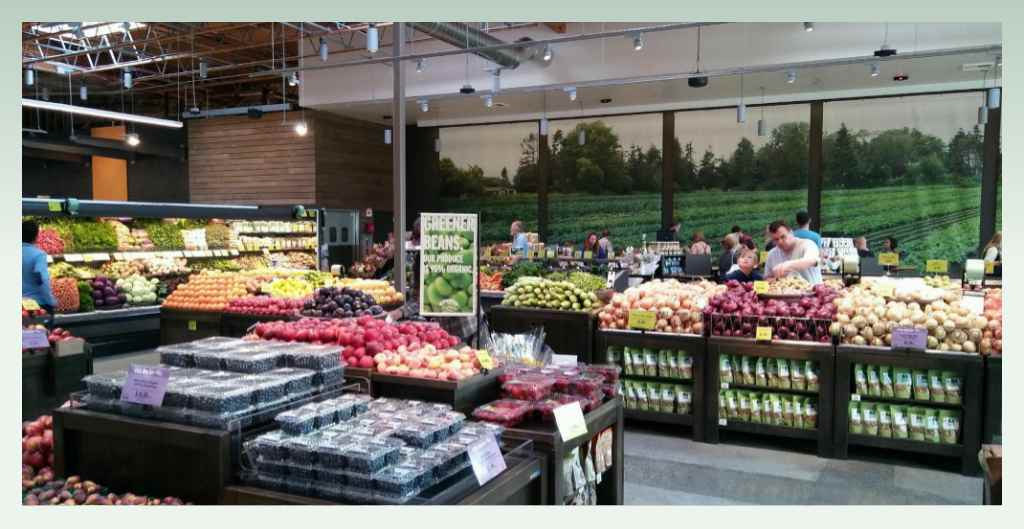
If you’re aspiring to open a go-to grocery store for locals, it could be a rewarding and lucrative venture.
Groceries are a necessity, so, even during an economic downturn, revenue from stores selling those commodities has always remained steadily high. And whether more merchants choose to do business online, having an on-ground store is still more convenient for local shoppers.
However, there’s a lot to think about when you decide to open your doors. Feeling overwhelmed with your lack of experience and don’t know where to begin? No worries. We will provide clear, practical guidance on how to start a small grocery business and help you understand the pros and cons right from the get-go. Let’s dive in.
Contents
- 1. How to start a small grocery store: Step-by-step guide
- 1.1. Find your niche
- 1.2. Research your market
- 1.3. Determine your startup and ongoing costs
- 1.4. Obtain necessary licenses and permits for your business
- 1.5. Choose the right location
- 1.6. Grocery store design & setup
- 1.7. Find wholesalers and choose your inventory
- 1.8. Set the product pricing
- 1.9. Hire employees
- 1.10. Market your store & retain buying customers
- 2. Pros and cons of opening a grocery store
- 3. PPC Community Markets: An example of a successful small grocery store
- 4. Turn your plan into reality
- 5. FAQs
1. How to start a small grocery store: Step-by-step guide
1.1. Find your niche
You’re unlikely to succeed if you sell something you love but no one needs, just as you are unlikely to succeed if you sell something super popular but lack interest and expertise. To start a grocery business successfully, it’s crucial to identify a niche that aligns with your interests and skills while satisfying the specific market needs.
Let’s say you are passionate about organic foods, and the demand for these healthy products has been growing. Go ahead, and be sure to select a location where there’s a market for your products.
Of course, there are many other unique grocery store ideas to inspire you. They are gluten-free groceries, seafood, retail ethnic groceries, etc. to name a few.

1.2. Research your market
Just having a big, well-designed store with a wide variety of goods doesn’t guarantee customers and revenue. The key step is to identify your target customers and understand your competitors. Without thorough research, you may waste a lot of money on the wrong location or goods that don’t meet their needs and affordability.
Don’t forget about your competitors. Learning from both their strengths and weaknesses is the best way to understand your target customers and become a go-to destination for locals. Also, be mindful of indirect competitors like local supermarkets—they might steal your customers someday.
By asking these questions, you’ll understand your market and make informed decisions.
Target customers:
- What is their affordability?
- What do they buy most frequently?
- Are there specific brands they prefer?
- What factors make them choose a grocery store over the rest?
Competitors:
- How many grocery stores are in your target areas?
- What goods do they sell, and what are they lacking?
- How do their prices compare to market averages?
- Do they offer discounts, promotions, or loyalty programs?
- How are their stores set up and arranged?
1.3. Determine your startup and ongoing costs
When developing your small grocery business plan, you’ll need to factor in startup and ongoing costs. This helps you ensure enough funds to cover necessary expenses and run your business smoothly.
If you don’t do this from the beginning, you might allocate an excessive amount of capital to certain aspects, such as store lease and setup, while not having enough money to source the expected number of goods.
Here are the main costs of starting a grocery store to take into consideration:
- Permit and licensing fees
- Location leasing
- Store setup
- Supplies, software, and hardware
- Inventory
- Employees
- Marketing
In addition, you should consider ongoing costs essential for maintaining the business. They include employee salaries and benefits, equipment and machinery maintenance, leasing, and utilities such as electricity, water, and internet.
1.4. Obtain necessary licenses and permits for your business
To open your grocery store legally, make sure to obtain the necessary licenses and permits.
These papers guarantee your company operates legally and ethically, all in an effort to safeguard the interests of consumers, employees, the environment, and the overall economic and social welfare. Also, choosing sustainability over just chasing profits will benefit your business in the long run.
Below are some licenses and permits you may need:
- Business License: Get a business license from your local authority. Applying for a business license requires your grocery store business name, structure, address, Tax Identification Number, etc.
- Seller’s Permit (Sales Tax Permit): Get a seller’s permit to collect and remit sales tax on taxable items if your location imposes a sales tax.
- Food Handler’s Permit: Obtain a health permit/license from the local health department if you sell ready-to-eat food.
- Alcohol License: Obtain a liquor license depending on your state regulation if you sell wine and/or beer.
- Building and Sign Permits: Ask competent authorities for building permits.
Depending on your location, the required licenses and permits may vary. So it’s advisable to check with your local authorities.
1.5. Choose the right location
Choosing the right location for your grocery store is a key factor to success. A grocery store mainly serves local shoppers, so it’s important to pick a location with a lot of people, including residential areas, apartment blocks, markets, etc.
However, choose a location where your target customers live. Suppose you’re planning to sell groceries for families—fresh produce, meats, dairy products, household items—it would be ideal if your store is located in a residential area rather than an office-centric location.
Additionally, consider the competition when searching for the ideal location. Check if there are other grocery stores or a local supermarket nearby. It’s best to place your store away from direct competitors. Alternatively, ensure you offer products that customers can’t easily find elsewhere.
Importantly, compare between what you pay for leasing and what you earn. You should opt for a $5,000 space over a $2,000 space if the former brings you a higher profit margin.
Some other factors to consider when choosing a location include parking, a safe environment, etc.
1.6. Grocery store design & setup
Once you’ve decided on the location, the next step is to design your store and purchase the necessary equipment.

It’s crucial to ensure that the layout is visually appealing and easy to navigate for customers, while also being convenient for the staff in terms of arrangement and management. For instance, arrange aisles logically, and put shopping carts or baskets near the entrance. And don’t forget to add a touch of aesthetics and branding.
Next, you’ll need to buy equipment for your grocery store, including:
- Shelves
- Lighting systems
- Refrigerators
- Baskets or shopping trolleys
- Signages
- Packaging
- Uniforms
- Cleaning supplies and equipment
- Security systems
- POS system: A POS system facilitates the transaction and manages inventory. This system includes hardware (a barcode scanner, cash register, and receipt printer) and software that helps you process transactions, track inventory in real-time, and create sales reports.
- Others
1.7. Find wholesalers and choose your inventory
Now it’s time to pick the products you want to sell. To decide what to offer and where to get it from, you need to lean on your target customers—their needs and affordability.
So, what types of goods to sell?
- If your target customers are on an average income, consider offering affordable essentials such as local veggies, fruits, milk, cheese, noodles, etc. Lower profits, but higher sales.
- If you cater to high-income earners, go for popular items while sourcing goods from reputable local and global brands (of course with high prices).
Where to get your goods from?
- It’s good to know that picking the right wholesalers can make a difference. Customers tend to buy from the grocery stores that offer the same product but at a slightly lower price. A wholesaler offering products at favorable prices is an ideal choice.
In addition, if you find wholesalers who allow post-paid options, you won’t have to stress too much about capital constraints.
1.8. Set the product pricing
Setting the right price for your products is a key factor that helps to attract customers and make money. Everyone loves a good deal, right? So, offering prices that are slightly lower than others can even attract more customers and boost your revenue.
To determine a competitive price, check out different sources on how to set a price that works for both you and your customers. The point is to make everyone happy – customers get a good deal, and you make a profit.
1.9. Hire employees
Based on your demand, you may need employees for tasks like handling financial transactions, keeping the store clean, and organizing goods and equipment. To hire reliable and customer-oriented staff, it’s advisable to interview them carefully.
After they’re hired, you need to train them thoroughly so that they can perform well and maintain a positive attitude toward everyone.

1.10. Market your store & retain buying customers
1.10.1. How to market a grocery store
The last step on how to start a grocery business in this article is to market to target customers on the platforms they’re using. Once your grocery store goes live, you need to make it known.
Here are some different ways to advertise your store and groceries, including both traditional and digital methods.
- Traditional marketing – Consider distributing leaflets in local areas where your target customers are likely to be—residential areas, apartment blocks, schools, markets, or other stores.
- Word of mouth – This can be the most powerful marketing tool. You can proactively ask for help from your family, friends, and satisfied customers to help spread the word.
- Google Business Profile – When you create a Google Business profile, your store’s details, including address, contact information, ratings, etc., show up on Google. If people search for grocery stores in the area, they’ll discover you.
- Website – After your store has run for a time, you can consider creating a website to diversify your revenue streams. Some website builders designed for small businesses include Shopify, WooCommerce, Wix, etc.
| Interested in eCommerce platforms to build your grocery e-store? Here is a series of articles centered around them: Shopify vs Wix 2023: Finding Your Online Store’s Perfect Match Shopify vs Etsy: Which is Best for Startups? Shopify vs Volusion: The Pros, Cons, and In-Between |
- Social media – You should leverage social media networks such as Facebook, Instagram, TikTok, etc. to market your products. For instance, you can join local apartment block groups to connect with residents and introduce your offerings.
- Marketplace: Consider selling on online marketplaces–like Amazon–where numerous sellers, including those offering groceries, come together.
1.10.2. How to keep customers coming back
It’s hard to attract customers to your store, but it’s even harder to keep them coming back. Here are some tactics to retain your customers you can consider.
- Keep customers engaged with competitive prices, especially those who shop frequently. If possible, offer free home delivery for high-volume orders.
- Deliver excellent customer service to encourage repeat visits. Greet customers with a warm, friendly smile, and always be courteous. Address customer issues promptly and professionally.
2. Pros and cons of opening a grocery store
Grasping the key steps on how to start a grocery business is crucial. That alone is not enough, though. You also must understand the pros and cons of opening a grocery store, so you can prepare yourself as much as possible, not only with money and expertise but also with willpower.

2.1. Pros
- Steady demand: Unlike businesses influenced by seasons or trends, the revenue from grocery stores has always been steady because they offer essential items for people’s lives.
- Diverse revenue streams: A grocery store offers a variety of products, such as fresh produce, dairy, meat, and packaged goods. This diversity ensures income from different sources, not just one product.
- Repeated purchases: Local shoppers are likely to become loyal customers of your grocery store after a few purchases.
2.2. Cons
- High initial costs: As mentioned earlier, starting up involves many costs, including lease, design, equipment, staff, utilities, etc. These add up to a high initial expense.
- Intensive competition: The grocery sector is highly competitive, with nearby grocery stores, local supermarkets, and even eCommerce stores as competitors. This makes it harder to attract and retain customers. To stay competitive, price competition is inevitable. That being said, if you can’t ensure a win-win for both you and your customers, you might end up with minimal profits, or worse, you could be pushed out of the market.
- Thin profit margins: Grocery stores usually have slim profit margins, 1% to 3%. Therefore, store owners often look to increase sales volume and optimize ongoing costs.
3. PPC Community Markets: An example of a successful small grocery store
Established in Seattle in 1953, PPC Community Markets, or PCC, originated as a food-buying club of 15 Seattle families. Fueled by a passion for delicious and healthy food, PCC has evolved into the largest community-owned food market in the USA, boasting 16 certified organic stores.

Their products are carefully selected, focusing on natural quality without artificial additives, preservatives, or colorings. Unsurprisingly, the fresh produce and meat offered by PPC have consistently received high ratings.
PPC Community Markets also started with small steps on their path to success. Now, you find yourself in the same position as PCC stood 70 years ago. Their story, hopefully, can inspire you to walk on your own journey with determination.
4. Turn your plan into reality
The grocery industry is ripe for profit, yet it’s also rife with competition. If you’ve chosen to venture into this path, start with basic steps that ensure your lasting success. Don’t rush into renting space or sourcing goods; instead, conduct careful market research and prepare sufficient resources before opening your doors. With a solid foundation in place, your grocery business will thrive sooner or later.
After our blog post, hopefully, you’ve taken a firm grasp of how to start a grocery business. Leave a comment below if you have any questions to share with us.
And don’t forget to follow ComStart.io for more interesting and practical articles on how to start a business.
5. FAQs
Of course. Grocery stores generally have a slim profit of around 3%. In return, they make money by selling large quantities. Meanwhile, stores selling specialty and high-end goods can see a higher profit of up to 10%.
To start a supermarket business, you may need about $250,000 on average.
Follow the same steps in this article to start a grocery store in a small town.
Step 1: Find your niche
Step 2: Understand your target customers and competitors
Step 3: Select the ideal location
Step 5: Find wholesalers
Step 6: Set the product prices
Step 7: Hire staff
Step 8: Promote your store
Compared to a mini grocery store or mini-mart, a mini supermarket is larger and offers a wide variety of products. If you’re launching a mini supermarket, here are the essential steps to follow.
Step 1: Research your market
Step 2: Calculate your startup and ongoing costs
Step 3: Register your business and get the necessary licenses and permits
Step 4: Seek funds from reliable organizations
Step 5: Select the location for your mini-mart
Step 6: Design and set up your mini supermarket
Step 7: Find the wholesales and choose inventory
Step 8. Set the product price
Step 9: Hire new employees
Step 10: Promote your mini supermarket
Follow these 9 steps on how to start a grocery business from home and online.
Step 1: Determine your target audience & analyze competitors
Step 2: Choose product categories to sell
Step 3: Register your business and acquire licenses/permits
Step 4: Find trustworthy wholesalers
Step 5: Find shipping and logistics providers
Step 6: Develop a well-functioned website
Step 7: Set up a smart payment system
Step 8: Promote your online grocery store
Step 9: Hire new employees








